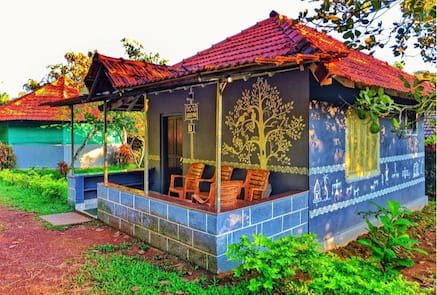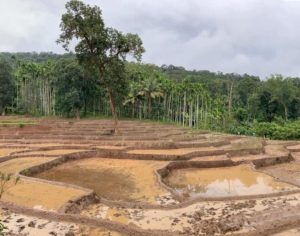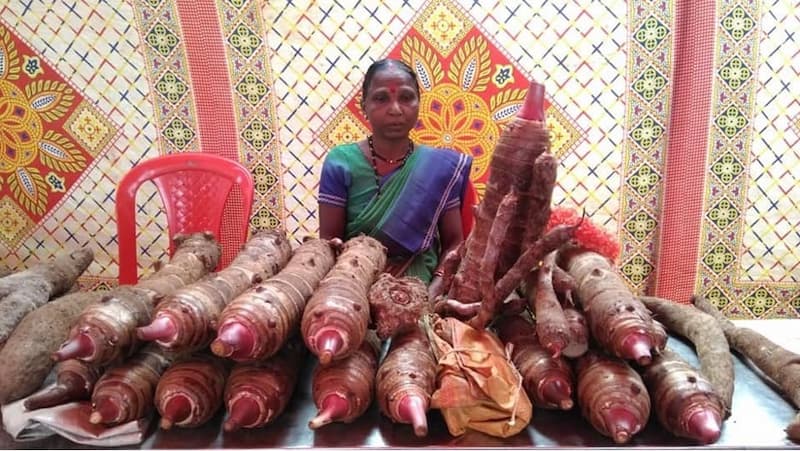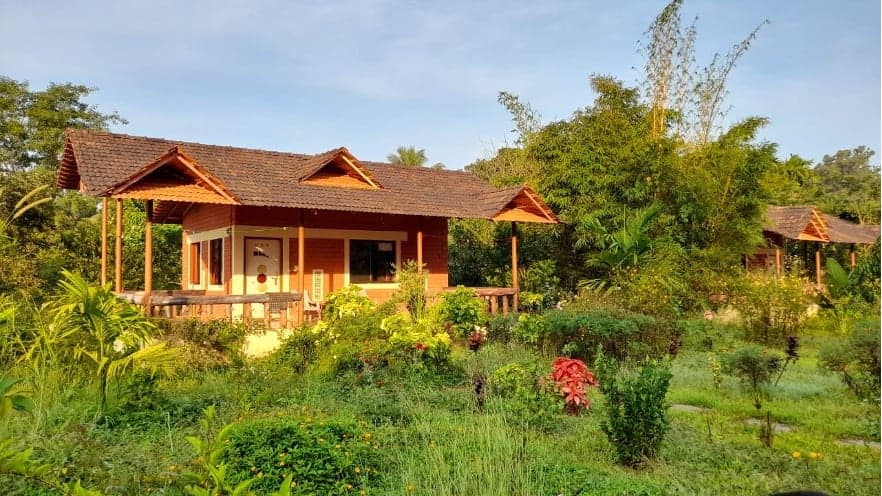Destination Stewardship Report – Autumn 2021 (Volume 2, Issue 2)
This post is from the Destination Stewardship Report (Autumn 2021, Volume 2, Issue 2), an e-quarterly publication that provides practical information and insights useful to anyone whose work or interests involve improving destination stewardship in a post-pandemic world.
Contrasting Tourism Landscapes in Karnataka, India
The pandemic exposed the dangers of ‘tourism monocultures’ – dependence on one product only – versus a more holistic approach to tourism fare. Gayathri Hegde has been researching the differing tourism experiences of Dandeli and Joida, neighbouring towns in Karnataka, southwestern India.

Amara homestay cottages decked in Warli paintings. Homestays such as this, combined with multicultural experiences, offer a resilient alternative to the risks inherent in over-exploiting a single adventure-tourism product. © Amrut Joshi
River Rafting Alone Does Not a Destination Make

Cultivated terraces and wild forests of Joida testify to multiple layers of influence by man and nature. © Gayathri Hegde.
The town of Dandeli, located in the serene, verdant green forests of Western Ghats in northern Karnataka, has become synonymous with ‘adventure tourism’ in the region, popularized as the river-rafting destination of southern India. Fueled by dam waters, the Kali River flows with robust furor, enthralling all visitors. The spike in tourists visiting this biodiversity hotspot brought considerable profits to tourism service providers, but it has also resulted in unchecked growth that has hampered the ecological and financial sustainability of this tourism model.
What was once a novelty experience has now been reduced to a gimmick in recent years. Rafting through the rapids was initially envisioned for a 12km stretch, which would allow the adventurer to have a complete experience of rafting through multiple rapids in the flowing river. However, to offer the experience to a larger number of visitors traveling on a smaller budget, the local tourism operators started offering the rafting experience for lower fees and a shorter distance. As a result, while the tourism experience in Dandeli has become more accessible across all economic classes of the society, the overall quality of the product has taken a massive hit.
In an attempt to cater to many, even the few are deprived of the delights of nature that this place truly has to offer. With no checks in place to regulate the tourism impacts, tourists are littering the area, and most service providers take no responsibility for restoring the disturbed places they leave behind. As a result, the once verdant landscape is now dotted with plastic and tin. The sensitive ecology is home to a multitude of flora and fauna that are endemic to the region. The unchecked spurt in tourism stands to upend their lifecycle.
Then, when the government banned water-sport activities as a preventive measure during Covid-19, many tourism service providers who had anchored their business model solely on adventure tourism took a major financial hit.
But what is unique about Dandeli? What can one take away from here? The actual potential of this place in the current tourism model does not benefit the tourist or the tourism vendor. It exploits the place without any regard to either maintaining the place or developing it more thoughtfully.
The Joida Model
Potential solutions to such challenges have been successfully and sensitively incorporated not too far away in the neighbouring region of Joida. Both Dandeli and Joida are home to many native communities, some of them tribal, who have immense knowledge about the ecology of the place and have several unique skills in arts and crafts, which can be leveraged for the benefit of both locals and visitors. Even the cuisine that is consumed locally is unique, featuring an array of tubers, which have an annual festival. This cuisine ought to be to featured in restaurants menus and be celebrated accordingly.

Annual tuber exhibition in Joida by the tribal Kunabi people. © Amrut Joshi.
In all of this, I see hope in a cluster of homestays of the region, which are modelled on the public-private profit (PPP) sharing approach for the purpose of providing the best experience of a nature retreat and a cultural taste of regional specialties.
Even when river rafting was closed and the bigger hotels and resorts suffered losses from their adventure-tourism business model, some homestays of the region were not affected by this decision. Rafting was only an add-on to their tourism products. These homestays are run by members of the local community who offer rare view into their own cultural diversity. In the remote village of Gund, last in the region, Amara Homestays offers Yakshagana (a local theatre and dance form) workshop for its visitors and offers meals typical of the Havyaka people. These opportunities are cherished by the visitors. The owner claimed that his business is sustained by repeat visitors who look forward to this experience.
My Take
In hindsight, Dandeli-Joida offers the perfect canvas to showcase a panorama of evolving tourism trends in smaller cities in India and their impacts on multiple levels. In my experience of having travelled across different parts of India over the years and of viewing it through a cultural lens, it struck me that often the ideal tourism experience for an Indian tourist in India is hinged primarily on material comforts more than having an immersive cultural experience. The representation of local cultural identity in built and intangible forms is lacking too.
When our tourist infrastructure does not reflect this in design or application, the disconnect is but a natural consequence. The gap here is due not only to the tourist who chooses familiar material comfort as his priority, but also to the way these experiences are curated. The idea of ‘ecotourism’ has found traction only in recent years, and we are still grappling with what it means. Textbook definitions and generic principles of ecotourism seem not very relevant for the region, while failing to recognize that the local traditional systems offer perfect solutions to this dilemma. [Editor: See instead the “geotourism approach” put forth via National Geographic.]
The contrasting tourism models I witnessed in Dandeli offer many lessons for building a sustainable tourism model in these eco-sensitive habitats, while creating a unique experience for the visitor and safeguarding the natural landscape and culture for the future.

Sangway homestay nestled in the greenery. © Amrut Joshi
About Gayathri Hedge
Gayathri is a conservation architect with Dual-Masters in World & Cultural Heritage. She has worked in India and internationally since 2012.




